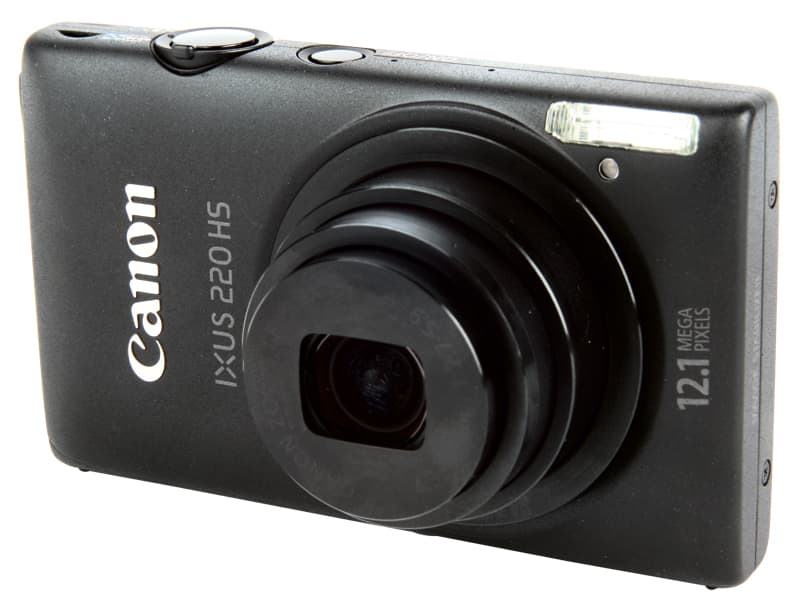Canon IXUS 220 HS review – Introduction
Canon’s IXUS cameras have long been style icons and the latest in the range has continued the trend. The mid-range Canon IXUS 220 HS has a textured stainless-steel body and features the HS system for better low-light control.
Although it is just over 92mm wide and 19.5mm deep, the Canon IXUS 220 HS has a host of clever features and, available in black, silver or red for a street price of around £170, it is likely to be one of the most popular models in the range of eight.
Build and handling
 The IXUS 220 HS, like many other new HS models, has seen a reduction in resolution from the model it replaces. This less-populated sensor makes noise easier to control and delivers improved results.
The IXUS 220 HS, like many other new HS models, has seen a reduction in resolution from the model it replaces. This less-populated sensor makes noise easier to control and delivers improved results.
The 220 HS’s 12.1-million-pixel sensor has 2 million pixels fewer than its predecessor, the IXUS 210, but with an output of 4000×3000 pixels it can still deliver a 10x13in print at 300ppi. The processor is Canon’s Digic 4 system which, combined with the high-sensitivity sensor, creates the HS system. This allows an ISO range of 100-3200, as well as up to ISO 6400 in low-light scene mode (at 3 million pixels).
Shooting modes are catered for by smart auto via the auto mode on the rear, which assesses the image and chooses from one of 32 modes. When switched to the camera symbol, the 220 HS offers a choice of program or a series of 24 selectable scene modes. Surprisingly, there is also a choice of three metering modes (centreweighted, evaluative and spot), and exposure compensation of ±2EV. This camera isn’t really about manual shooting, though, and is very much geared up for the point-and-shoot experience.
While the focusing offers a choice of modes, including centre and tracking, the AiAF intelligent focusing takes care of most scenes, automatically picking from nine AF points or detecting faces. There is no option for manual focus, but few people will miss it.
Despite its small size, using the 220 HS is easy thanks to the large well-spaced buttons. There are three buttons and a switch around a d-pad on the rear, a shutter with surrounding zoom switch and a power button on the top. Both start-up time and operation of the zoom are rapid, taking just over a second to start and about two seconds from wide to telephoto.
The lens gives a 5x zoom range from a nice wide 24mm for landscapes to a respectable 120mm equivalent for portraits or action with an f/2.7-5.9 aperture.
Stabilisation is lens-based, allowing you to shoot at shutter speeds up to 4EV slower handheld to avoid camera shake, and there is dynamic stabilisation for video.
Video can be captured in Full 1080p HD at 24fps, or 720p at 30fps. There is also a high-speed video that will shoot 120fps at 640×480 or 240fps at 320×240 pixels.
The camera’s textured finish makes it very tactile and it feels very solid in the hand.
Performance

The monochrome mode is ideal for moody landscapes such as this
Images are natural in their colouring and don’t suffer from oversharpening or high-contrast processing that affects many cheaper compacts. It is possible to get some wilder effects, though, using the various scene modes. Some of these can be appealing, such as the miniature mode and the selective colouring. Detail is well maintained and there is minimal fringing in the high-contrast regions.
At high sensitivities the images are clear and well coloured, although noise reduction is obviously playing its part and luminance noise is evident on close inspection. The AF system has no problem locking on and is bolstered by a powerful AF beam in low-light situations. The low-light scene mode is impressive despite its lower resolution, but for the sake of an extra stop it is probably not worth the increase in noise.
The LCD screen is a slight letdown, not for its size, as this already fills most of the rear panel, but more for the resolution and colour. The screen appears quite contrasty, which doesn’t show the images at their best, and with a 230,000-dot resolution it lacks the detail for critical appraisal.
Our Verdict
The Canon IXUS 220HS is a very capable point-and-shoot camera that produces well-detailed, natural-looking images. If you’re after a pocket-sized camera to keep with you that is fast and requires little manual interaction, then this camera is worth considering.







